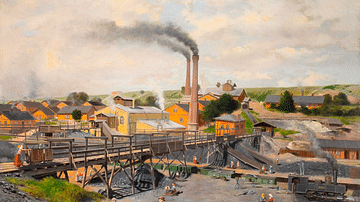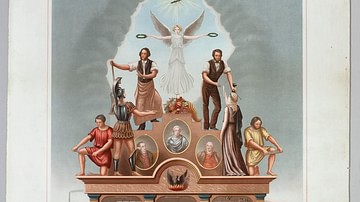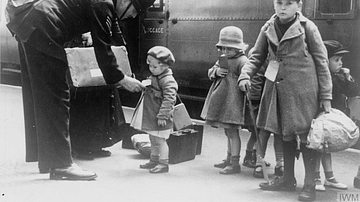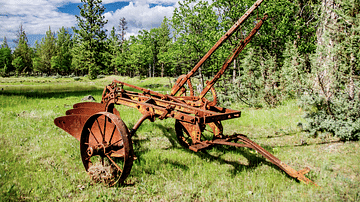Children were widely used as labour in factories, mines, and agriculture during the British Industrial Revolution (1760-1840). Very often working the same 12-hour shifts that adults did, children as young as five years old were paid a pittance to climb under dangerous weaving machines, move coal through narrow mine shafts, and work in agricultural gangs.
It was very often the case that children's jobs were well-defined and specific to them, in other words, child labour was not merely an extra help for the adult workforce. The education of many children was replaced by a working day, a choice often made by parents to supplement a meagre family income. It was not until the 1820s that governments began to pass laws that restricted working hours and business owners were compelled to provide safer working conditions for everyone, men, women, and children. Even then a lack of inspectors meant many abuses still went on, a situation noted and publicised by charities, philanthropists, and authors with a social conscience like Charles Dickens (1812-1870).
A Lack of Education
As sending a child to school involved paying a fee – even the cheapest asked for a penny a day – most parents did not bother. Villages often had a small school, where each pupil's parents paid the teacher, but attendance was sometimes erratic and more often than not the education rudimentary in hopelessly overcrowded classes. There were some free schools run by charities, and churches often offered Sunday school. Not until 1844 were there more free schools available, such as the Ragged schools established by Anthony Ashley-Cooper, 7th Earl of Shaftesbury (1801-1885). These schools concentrated on the basics, what became known as the 3 Rs of Reading, Writing, and Arithmetic. Compulsory education for 5 to 12-year-olds, and the institutions necessary to provide it, would not come along until the 1870s. Consequently, "at least half of nominally school-age children worked full-time during the industrial revolution" (Horn, 57).
Some factory owners were more generous than others to the children in their employ. An example is the Quarry Bank Mill in Styal in the county of Cheshire. Here the owner provided schooling after the long working day was over for 100 of its child workers in a dedicated building, the Apprentice House.
An indicator of better education, despite all the difficulties, is literacy rates, rather imperfectly measured by historians by recording the ability of a person to sign one's name on official documents such as marriage certificates. There was a great improvement in literacy, but by 1800, still only half of the adult population could sign their name to such documents.
For those children who could find work in the Industrial Revolution, and there were employers queueing up to offer it, there were no trade unions to protect them. For the vast majority of children, working life started at an early age – on average at 8 years old – but as nobody really cared about age, this could vary wildly. Working involved at best tedium and at worst an endless round of threats, fines, corporal punishment, and instant dismissal at any protest to such treatment. In one survey taken in 1833, it was found that the tactics used with child labourers were 95% negative. Instant dismissal accounted for 58%. In only 4% of cases was a reward given for good work, and a mere 1% of the strategies used involved a promotion or pay rise.
Traditional Child Work
In the traditional cottage industry of handweaving, children had always washed and carded raw wool so that their mother could spin it on a spinning wheel, which then was woven into fabric by the father using a handloom. Craftworkers often took on an apprentice or two. Apprentices were given their board and lodgings and taught a particular trade by their master. In return, the child not only worked for free but was expected to pay a large fee upfront before starting a contract that could last a year or several years or even up to seven years, depending on the trade. Then there were children who worked in their parents' or relations' small businesses, such as small-scale manufacturers like basket-weavers, blacksmiths, and potters.
Children worked in agriculture, still a significant area during the Industrial Revolution and one which involved 35% of Britain's total workforce in 1800. Children, as they always had done, continued to tend herds of animals and flocks of fowl, and they essentially performed any task required that they were physically capable of. Many children joined agricultural gangs which moved around to where there was temporary or seasonal employment.
Children in Mines
Men, women, and children worked in Britain's mines, particularly in the coal mines, which boomed as they produced the fuel to feed the steam engines of the Industrial Revolution. All three groups had been involved in mining before the arrival of machines, but the industry's expansion meant that many more were now involved than previously. Children as young as five years old were found useful by mine owners since they were small enough to climb into narrow ventilation shafts where they could ensure that trapdoors were regularly opened and shut. Testimony like James Pearce's in 1842 was common:
I am 12 years of age. I went down to the pits about 7 years and a half to open doors. I had a candle and a fire beside me to show me light…I was 12 hours a-day, and got 6d a day. I attended and got the money. When I was paid I took it home to my mother. I was a year and a half at this work. I once fell asleep and was well threshed by a driver.
(Shelley, 42)
Most children, as they got older, were then employed to either shift the coal from the working level to the surface or to sort it out from other debris before it was shipped away. Those who pulled the coal in carts using a harness were known as 'hurriers', and those who pushed were 'thrusters'. This was back-breaking work detrimental to the child's physical development. Many parents were not opposed to their children working, despite the health hazards, since they brought in much-needed earnings for the family. In addition, over half of the children working in mines kept their employment when they reached adulthood, so it was a good route to secure a job for life. From 1800 to 1850, children composed between 20-50% of the mining workforce.
The consequence of working at such an early age was that most children employed in mines never had more than three years of schooling. Children very often suffered health problems from the physical hard work and long, 12-hour shifts. Breathing in coal dust year after year caused many to develop lung diseases later in life. As the historian S. Yorke emphatically notes, "The coal mining industry must represent one of the worst exploitations of men, women and children ever to have taken place in Britain" (98).
Children in Factories
Factories with new steam-powered machines like power looms were the great development of the Industrial Revolution, but they came at a cost. These places, especially the textile mills, were dark and noisy, and they were deliberately kept damp so that the cotton threads were more supple and less likely to break. The new mechanization of manufacturing meant that few skills were needed anymore for the basic workforce. Children were required to go under the machines to clear up cotton waste for reuse or to repair broken threads or remove blockages from the machinery. This was often dangerous work as the machines could be unpredictable. A massive weaving machine might come to a crashing halt with heavy parts falling down and movable pieces like spindles flying around like bullets.
In the factories, children worked, just like the adults around them, long 12-hour shifts six days a week. 12 hours nicely split the day in two for employers. As the machines were operated 24 hours a day, one child would return to a warm bed after work as the occupant rolled out to start their own shift, a practice known as 'hot bedding'. Children were the cheapest labour to be found, and employers were not slow to use them. A child worker was about 80% cheaper than a man and 50% cheaper than a woman. Children had the advantage of having nimble fingers and smaller bodies that could get into places and under machinery that adults could not. They could also be bullied and threatened by supervisors much more easily than an adult, and they could not fight back.
Children were also apprenticed to factory owners in a system similar to indenture. Parents were given money by their parish to allow their children to work in factories. The practice was common, and it was not until 1816 that a limit was put on how far away the children were required to work – 64 km (40 mi).
Children made up around one-third of the workforce in Britain's factories. In 1832, as the Industrial Revolution reached its final decade, these children were still subject to appalling working conditions in factories, as here described by the MP Michael Sadler, who pressed for reform:
Even, at this moment, while I am thus speaking on behalf of these oppressed children, what numbers of them are still at their toil, confined to heated rooms, bathed in perspiration, stunned with the roar of revolving wheels, poisoned with the noxious effluvia of grease and gas, til at last, weary and exhausted, they turn out almost naked, plunge into the inclement air, and creep shivering to beds from which a relay of their young work-fellows have just risen; and such is the fate of many of them at the best while in numbers of instances, they are diseased, stunted, crippled, depraved, destroyed.
(Shelley, 18)
The Poor & Orphans
Children without homes and a paid position elsewhere were, if boys, often trained to become a Shoe Black, that is someone who shined shoes in the street. These paupers were given this opportunity by charitable organisations so that they would not have to go to the infamous workhouse. The workhouse was brought into existence in 1834 and was deliberately intended to be such an awful place that it did little more than keep its inhabitants alive in the belief that any more charity than that would simply encourage the poor not to bother looking for paid work. The workhouse involved what its name suggests – work, but it was tedious work indeed, typically unpleasant and repetitive tasks like crushing bones to make glue or cleaning the workhouse itself. No wonder, then, given the squalid life in the workhouse, that many children worked in factories and mines.
Government Labour Reforms
Eventually, governments did what the fledgling trade unions had struggled to achieve, and from the 1830s, the situation for workers in factories and mines, including for children, began to slowly improve. Previously, governments had always been reluctant to restrict trade in principle, preferring a laissez-faire approach to economics. It did not help that many members of Parliament were themselves large-scale employers. Nevertheless, several acts of Parliament were passed to try, although not always successfully, to limit employers' exploitation of their workforce and lay down minimum standards.
The first industry to receive restrictions on worker exploitation was the cotton industry, but soon the new laws applied to workers of any kind. The 1802 Health and Morals of Apprentices Act stipulated that child apprentices should not work more than 12 hours a day, they must be given a basic education, and they must attend church services no fewer than two times each month. More acts followed, and this time they applied to all working children. The 1819 Cotton Mills and Factories Act limited work to children 9 years or over, and they could not work for more than 12 hours per day if under 16 years of age. Possible working hours for children were established as between 6 a.m. and 9 p.m. The 1833 Factory Act stipulated that children in any industry could not be legally employed under 9 years of age and could not be asked to work for more than 8 hours each day if aged 9 to 13, or no more than 12 hours each day if aged between 14 and 18. The same act prohibited all children from working at night and made it obligatory for children to attend a minimum of two hours of education each day.
Although there were many abuses of the new regulations, there were government inspectors tasked with ensuring they were followed. These officials could demand, for example, age certificates for any child employee or a certificate from a schoolmaster that the required number of hours of education had been given to a specific child.
Progressive changes followed the earlier acts. The 1842 Mines Act stipulated that no child under 10 years of age could be employed in underground work. The 1844 Factory Act limited anyone's working day to 12 hours, dangerous machines had to be placed in a separate workspace, and sanitary regulations were imposed on employers. The 1847 Factory Act further limited the working day to a maximum of 10 hours, a reduction that campaigners had long been lobbying the government to make. There were still many abusers of the new laws, and many parents still desperately needed the extra income their working children brought, but attitudes were finally changing in wider society in regard to using children for labour.
Authors like Charles Dickens wrote such damning works as Oliver Twist (1837) that pointed out the plight of poorer children. In the moralism of the Victorian period, many people now wanted children to preserve their innocence longer and not be so early exposed to the temptations and moral pitfalls of adult life. The idea that childhood was worth keeping but could be lost if not protected saw the foundation of the National Society for the Prevention of Cruelty to Children in 1889. The arts continued to prick people's consciences. J. M. Barries' character of Peter Pan, which first appeared in 1901, confirmed this shifting of attitudes and the realisation and recognition that childhood was a thing of value in and of itself, a precious thing that should not be obliterated in the daily grind of mines and factories.










